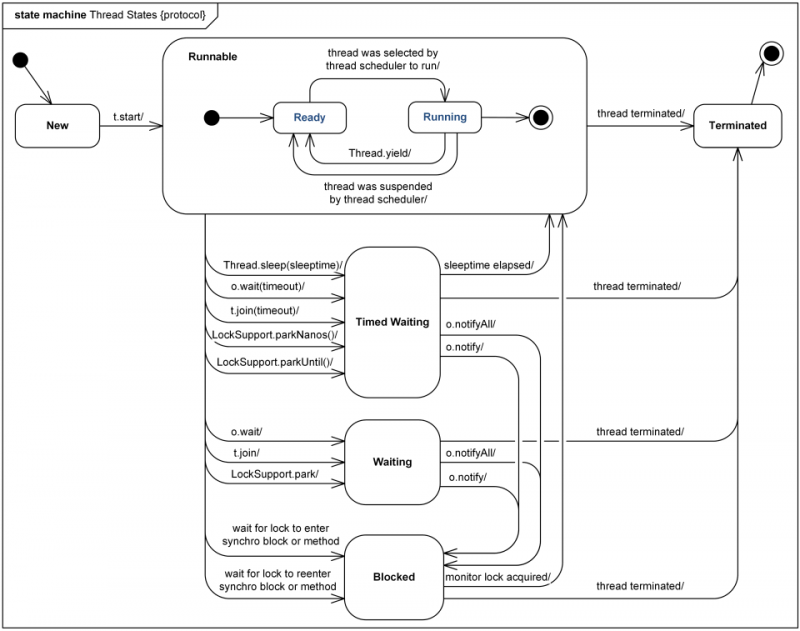“Java的阻塞、等待及相关方法”的版本间差异
跳到导航
跳到搜索
(→关于线程状态) |
(→相关方法) |
||
| (未显示同一用户的4个中间版本) | |||
| 第6行: | 第6行: | ||
== 关于线程状态 == | == 关于线程状态 == | ||
线程(进程)的运行状态,最基本的三种:“就绪”、“运行”、“阻塞”。在此基础上,不同的系统进行了扩展(如:“新建”、“死亡”、“等待”、“挂起”)形成了五状态、六状态、甚至七状态模型。 | |||
但是,在 Java(JVM) 中,仅有六种状态: | |||
'''These states are virtual machine states which do not reflect any operating system thread states.''' | |||
'''这些状态是虚拟机状态,不反映任何操作系统线程状态。''' | |||
(网上查到的相关内容,很多都按五种状态分析,可能没看源码,按惯性思维来了,或者1.5以前版本是那样?) | |||
根据'''“Thread”源码'''可以发现,其线程公有'''六种'''状态:“<span style="color: blue; font-size: 120%">'''New'''</span>”、“<span style="color: blue; font-size: 120%">'''Runnable'''</span>”、“<span style="color: blue; font-size: 120%">'''Blocked'''</span>”、“<span style="color: blue; font-size: 120%">'''Waiting'''</span>”、“<span style="color: blue; font-size: 120%">'''Timed_Waiting'''</span>”、“<span style="color: blue; font-size: 120%">'''Terminated'''</span>”。 | |||
: <syntaxhighlight lang="java"> | |||
<syntaxhighlight lang="java"> | |||
public enum State { | public enum State { | ||
/** | /** | ||
| 第75行: | 第84行: | ||
} | } | ||
</syntaxhighlight> | </syntaxhighlight> | ||
其中: | 其中: | ||
# | #“'''Runnable'''”可以理解为“就绪”+“运行”; | ||
# | #“'''Blocked'''”:用于标识'''线程等待一个监视器锁'''; | ||
#: 如:【?】 | #: 如:【?】 | ||
## 进入 synchronized 标记的代码块或方法; | ## 进入 synchronized 标记的代码块或方法; | ||
## 调用“Object. | ## 调用“Object.wait”之后,重入 synchronized 标记的代码块或方法; | ||
# | #“'''Waiting'''”:用于标识'''线程等待另一个线程执行特定操作'''; | ||
#: 如: | #: 如: | ||
## “Object.wait()” | ## “Object.wait()” | ||
## “Thread.join()” | ## “Thread.join()” | ||
## “LockSupport.park()” | ## “LockSupport.park()” | ||
# | #“'''Timed_Waiting'''”:'''具有指定等待时间的“Waiting”状态''' | ||
#: 如:(方法带有时间参数) | #: 如:(方法带有时间参数) | ||
## “Object.wait(long timeout)” | ## “Object.wait(long timeout)” | ||
| 第101行: | 第105行: | ||
*(并非像网上所说,“阻塞”分为:“同步阻塞”、“等待阻塞”、“其他阻塞”) | *(并非像网上所说,“阻塞”分为:“同步阻塞”、“等待阻塞”、“其他阻塞”) | ||
== 状态转换 == | == 状态转换 == | ||
找到了一个靠谱的状态转换图: | 找到了一个靠谱的状态转换图: | ||
[[File:Java线程状态转换. | : [[File:Java线程状态转换.png|800px]] | ||
== 相关方法 == | == 相关方法 == | ||
'''只有在线程 running 的时候,才会获取 cpu 片段''' | |||
需要区分的几个方法: | 需要区分的几个方法: | ||
# Object. | # '''Object.wait''':'''释放cpu,释放锁''',进入线程等待池中等待被再次唤醒(notify 随机唤醒,notifyAll 全部唤醒,线程结束自动唤醒),即放入锁池中竞争同步锁。 | ||
# Thread. | #: wait 应该与 notify、notifyAll 搭配,'''用作对象内部锁“Synchronized”的内部条件'''; | ||
# Thread. | # '''Thread.sleep''':(静态方法)'''释放cpu,保持锁'''(见源码注释“The thread does not lose ownership of any monitors”)。 | ||
# Thread. | # '''Thread.yeild''':(静态方法)使当前线程'''让出CPU''',进入线程池等待分配CPU。 | ||
# LockSupport. | # '''Thread.join''':让当前线程等待指定线程终结。('''源码中调用了“Object.wait”''',即“'''释放cpu,释放锁'''”) | ||
# '''LockSupport.park'''<ref>参考:'''[[关于“LockSupport.park”]]'''</ref>:(静态方法)'''释放cpu,保持锁'''。 | |||
== 参考 == | |||
<references/> | |||
2022年11月30日 (三) 09:45的最新版本
前言
刚刚正在梳理Java并发部分的知识点,(《Java核心技术卷1》与以前做的笔记),发现这部分出入比较大。所以单开一个词条,用于相关笔记的整理。【2020/10/19 20:50:10】
关于线程状态
线程(进程)的运行状态,最基本的三种:“就绪”、“运行”、“阻塞”。在此基础上,不同的系统进行了扩展(如:“新建”、“死亡”、“等待”、“挂起”)形成了五状态、六状态、甚至七状态模型。
但是,在 Java(JVM) 中,仅有六种状态:
These states are virtual machine states which do not reflect any operating system thread states.
这些状态是虚拟机状态,不反映任何操作系统线程状态。
(网上查到的相关内容,很多都按五种状态分析,可能没看源码,按惯性思维来了,或者1.5以前版本是那样?)
根据“Thread”源码可以发现,其线程公有六种状态:“New”、“Runnable”、“Blocked”、“Waiting”、“Timed_Waiting”、“Terminated”。
public enum State { /** * Thread state for a thread which has not yet started. */ NEW, /** * Thread state for a runnable thread. A thread in the runnable * state is executing in the Java virtual machine but it may * be waiting for other resources from the operating system * such as processor. */ RUNNABLE, /** * Thread state for a thread blocked waiting for a monitor lock. * A thread in the blocked state is waiting for a monitor lock * to enter a synchronized block/method or * reenter a synchronized block/method after calling * {@link Object#wait() Object.wait}. */ BLOCKED, /** * Thread state for a waiting thread. * A thread is in the waiting state due to calling one of the * following methods: * <ul> * <li>{@link Object#wait() Object.wait} with no timeout</li> * <li>{@link #join() Thread.join} with no timeout</li> * <li>{@link LockSupport#park() LockSupport.park}</li> * </ul> * * <p>A thread in the waiting state is waiting for another thread to * perform a particular action. * * For example, a thread that has called <tt>Object.wait()</tt> * on an object is waiting for another thread to call * <tt>Object.notify()</tt> or <tt>Object.notifyAll()</tt> on * that object. A thread that has called <tt>Thread.join()</tt> * is waiting for a specified thread to terminate. */ WAITING, /** * Thread state for a waiting thread with a specified waiting time. * A thread is in the timed waiting state due to calling one of * the following methods with a specified positive waiting time: * <ul> * <li>{@link #sleep Thread.sleep}</li> * <li>{@link Object#wait(long) Object.wait} with timeout</li> * <li>{@link #join(long) Thread.join} with timeout</li> * <li>{@link LockSupport#parkNanos LockSupport.parkNanos}</li> * <li>{@link LockSupport#parkUntil LockSupport.parkUntil}</li> * </ul> */ TIMED_WAITING, /** * Thread state for a terminated thread. * The thread has completed execution. */ TERMINATED; }
其中:
- “Runnable”可以理解为“就绪”+“运行”;
- “Blocked”:用于标识线程等待一个监视器锁;
- 如:【?】
- 进入 synchronized 标记的代码块或方法;
- 调用“Object.wait”之后,重入 synchronized 标记的代码块或方法;
- “Waiting”:用于标识线程等待另一个线程执行特定操作;
- 如:
- “Object.wait()”
- “Thread.join()”
- “LockSupport.park()”
- “Timed_Waiting”:具有指定等待时间的“Waiting”状态
- 如:(方法带有时间参数)
- “Object.wait(long timeout)”
- “Thread.join(long millis)”
- “Thread.sleep(long millis)”
- “LockSupport.parkNanos(long nanos)”
- “LockSupport.parkUntil(long deadline)”
- (并非像网上所说,“阻塞”分为:“同步阻塞”、“等待阻塞”、“其他阻塞”)
状态转换
找到了一个靠谱的状态转换图:
相关方法
只有在线程 running 的时候,才会获取 cpu 片段
需要区分的几个方法:
- Object.wait:释放cpu,释放锁,进入线程等待池中等待被再次唤醒(notify 随机唤醒,notifyAll 全部唤醒,线程结束自动唤醒),即放入锁池中竞争同步锁。
- wait 应该与 notify、notifyAll 搭配,用作对象内部锁“Synchronized”的内部条件;
- Thread.sleep:(静态方法)释放cpu,保持锁(见源码注释“The thread does not lose ownership of any monitors”)。
- Thread.yeild:(静态方法)使当前线程让出CPU,进入线程池等待分配CPU。
- Thread.join:让当前线程等待指定线程终结。(源码中调用了“Object.wait”,即“释放cpu,释放锁”)
- LockSupport.park[1]:(静态方法)释放cpu,保持锁。
